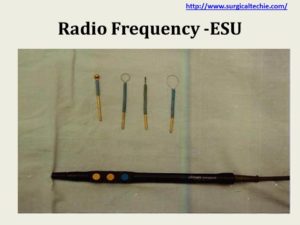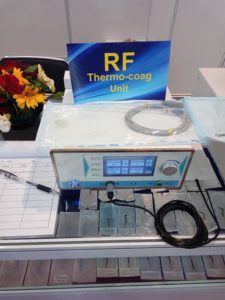The Radiofrequency is a medical-surgical device used mainly for the purpose of the open surgery, cosmetic surgery and Endoscopic surgery that includes Laparoscopy, Robotics surgery. Radiofrequency Machine topic will guide you the knowledge to use in clinical and surgical practices like radiofrequency ablation. With the help of Radiofrequency technology to produce waves for the radiofrequency treatment in surgery and, etc
Indication of Radiofrequency
Minimally invasive surgery like Laparoscopy, Robotic Surgery, and Endoscopic Procedures
Orthopedics surgery
Spine surgery
Pain Clinics
Dermatology
Ophthalmology
Gynecology
ENT
Plastic and Reconstructive surgery
The special type of instruments and forceps used along with the console
The separate cables and electrodes designed for the Indication. The Ergonomic design that exists in all equipment and instrument for the not only the purpose of user-friendly, for a good outcome and achieves targets
RF-Radio frequency Machine working Principle
It works on the principle that converts the Electric voltage current into thermal energy for cutting and coagulation of tissue and related structures. the working temperature of 40°C-70 °C
Radiofrequency Technology uses low-temperature cutting, the water molecules in the tissue vibrates violently under the influence of radiofrequency and electromagnetic waves. As a result, causes collision and rupture of cell and cutting of tissue. The main advantage of RF technology reduces blood loss during surgery while comparing to other Endosurgical Units.
Monopolar of Input 4.0 MHz converts into 1 W – 120 W
Bipolar of Input 1.71 MHz converts into 1 W- 50 W
Modes in Radiofrequency
Cutting
Coagulation
Cutting and Coagulation
Ablation
Instruments used in Radiofrequency Machine
All the Radiofrequency electrode are combined with ablation and Coagulation of the target tissue
- Endoscopic Bipolar Forceps
- Normal open surgery Forceps (Pencil type) Monopolar
Under monopolar tip may differ like
- Fine tip
- Ball tip
- Needle tip
- Spatula
- Ring type tip
- Bipolar forceps Cable with forceps
Uses of Radiofrequency treatment
For Endoscopy– Radiofrequency Ablation system is available with a bipolar tip electrode.
For all the radiofrequency electrode cable better to spray the springling NS-Normal Saline while using
The principle that delivers energy according to the tissue, Ablation and coagulation principle works with perfect techniques
In Neurosurgery ablation of nucleus pulposus in the intervertebral disc coagulation
Trigeminal Neuralgia radio treatment
Spinal Nerve radio frequency Treatment of pain
Dermatology
Use of low temperature, enhance the cutting to minimize tissue damage by thermal power.
Provide an accurate temperature
Targeted thermos coagulation
With footswitch/Negative plate
Thermo-coag electrode and needle used in the console enhance the user experience
Clinical uses in Dermatology
Facial Plastic surgery
Mandibular Reconstruction
Haemangioma
Mole Removal
Skin Tightening Treatment
Breast Cutting
Clinics use in Ophthalmology
Orbital Neoplasm
Tumor-related to Orbit
Ptosis surgery
Double eyelid operation
Eye cosmetic Procedure like angular develop, overpronation
Clinical uses of RF Technology in Gynecology
Cervical Polyp resection, Uterine Fibroid resection
Hysteromyoma Resection
Cervical mucous membrane resection
Cervical Biopsy
Clinical application of RF Technology in Stomatology
Gingiva removal
Abscess incision & drainage
Perisplenectomy
Fibroma
Fistula
Lacerectomy
Removal of hyperplastic Gums
The universally used high frequency operating electrode with 1.6 mm that used in common open surgery.
The radiofrequency needs the Neutral plate/patients plate in case of using Monopolar Electrode.
Radiofrequency comparison of other types of equipment by tissue damage
CO2 LASER 0.2 mm
Holmium LASER 0.5 mm
High Frequency 1.0 mm
